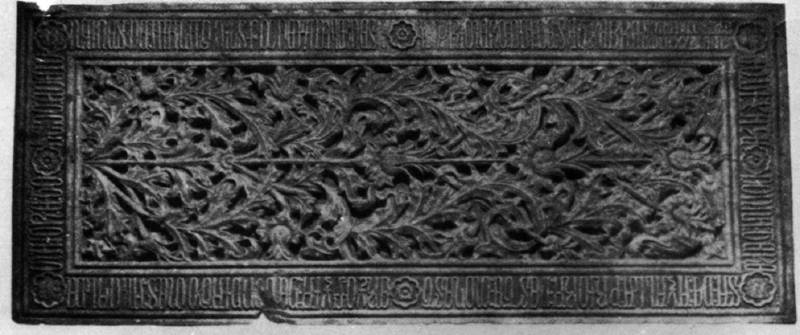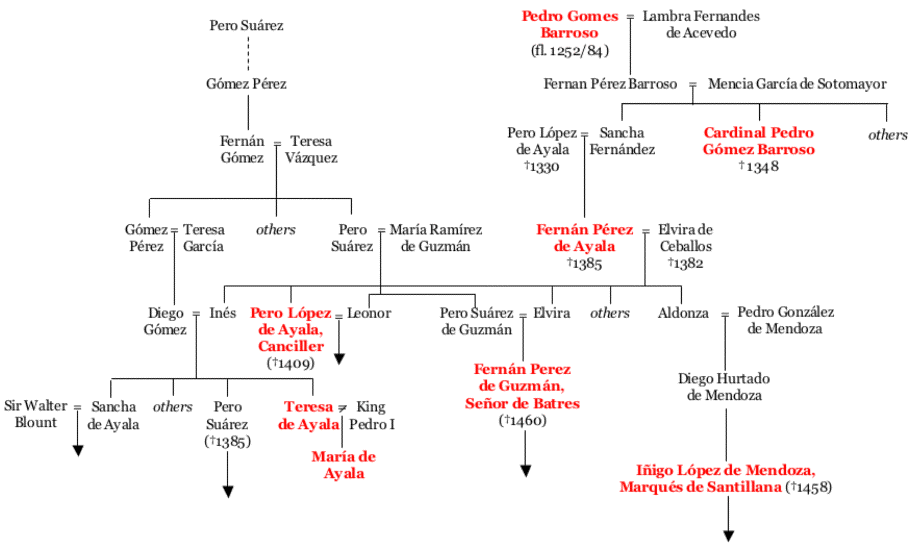
Tomb of Teresa de Ayala, at Santo Domingo el Real, Toledo.
Photo from Balbina Martínez Caviro, Mudéjar toledano: palacios y conventos (Madrid, 1980).
The Literary Heritage of Sancha de Ayala
draft: 11/27/2004
copyright © 2004 by Nathaniel Lane Taylor
Sancha de Ayala was born into a family with interesting connections in Toledo and the Castilian kingdom at large. Though her family was not of the first rank of the nobility, it is fascinating that she should be so well linked, by blood and by patronage, to the most important figures of the proto-Renaissance of Castilian letters. Sancha’s maternal uncle, the politician, poet and chronicler Pero López de Ayala, is the best known member of an extended literary dynasty whose intellectual luster far outshines that of the English family into which Sancha married.1 The literary legacy reaches beyond Pero López’s own father, Fernán Pérez de Ayala (also a writer),2 to Fernán Pérez' maternal uncle Pero Gómez Barroso, bishop of Cartagena and the 'Cardinal of Spain', who was intimately connected to the pre-Renaissance humanist culture at Avignon, and to whom is attributed one extant political tract, the Libro de consejos y de los consejeros.3 The legacy goes back through him ultimately to his own ancestor, the Galician-Portuguese troubadour poet Pero Gómez Barroso, a courtier to King Alfonso X, whose court in the mid thirteenth century set a cultural standard for all of Christian Spain.4 These Barroso and Ayala families were politically and culturally followers of the royal house of Don Juan Manuel, a writer and patron himself, nephew of King Alfonso X and ancestor of the later house of Trastamara, with whose fortunes Pero López de Ayala would be tied.5
One of Sancha's own sisters, Teresa de Ayala, was (briefly, as a very young teenager) mistress of King Pedro I, to whom she bore a daughter, María de Ayala: both mother and daughter had long careers at the Dominican convent of Santo Domingo el Real in Toledo, where they lie buried in the convent’s chapel.6 True to their family tradition, but unusual for their sex, Teresa and María left a remarkable literary legacy of her own: a long series of correspondence with members of the royal Trastamara house—a remarkable relationship, considering their ties as former mistress and daughter of the Trastamaras' murdered ex-rival, King Pedro I.

Tomb of Teresa de Ayala, at Santo Domingo el Real, Toledo.
Photo from Balbina Martínez Caviro, Mudéjar
toledano: palacios y conventos (Madrid, 1980).
The literary heritage would descend further into the fifteenth century with younger cousins of Sancha, including her paternal second cousin and maternal first cousin Fernán Pérez de Guzmán (d. 1460), author of the Generaciones y semblanzas, a masterwork of political biography in the Roman tradition;7 and another maternal cousin Iñigo López de Mendoza, the Marqués de Santillana (d. 1458), one of the great poets of the Castilian Renaissance.8 Both men stand at the head of literary dynasties stretching into the later Renaissance: the Marqués de Santillana is ancestor to the seventeenth-century poet Diego Hurtado de Mendoza, while Fernán Pérez de Guzmán is great-grandfather to the poet Garcilaso de la Vega. Much of this intellectual and blood lineage, from Fernán Pérez de Ayala on down through the Mendozas, is profiled by Nelen Nader in The Mendoza Family in the Spanish Renaissance, 1350-1550 (Rutgers, 1979). This book is available on line in html form through the LIBRO server of the American Academy of Research Historians of Medieval Spain (the server is currently hosted by the University of Central Arkansas).
The following chart shows some of these most important relationships.

Notes
1. There is a large body of critical literature about Pero López de Ayala, including, in English, the volume by Constance L. Wilkins, Pero López de Ayala, in the Tawyne World Authors Series (Boston, 1989). Professor Wilkins also produced editions of the most important of his chronicles: Coronica del rey don Pedro, ed. Constance L. Wilkins and Heanon M. Wilkins (Madison, Wisconsin, 1985); and Coronica de Enrique III, ed. Constance L. Wilkins and Heanon M. Wilkins (Madison, Wisconsin, 1992). Of his literary works, the newest critical edition of the Rimado de palacio, ed. H. Salvador Martínez (New York: Peter Lang, 2000), includes a valuable and comprehensive introduction (in Spanish) to the man and his work. Other masterworks include the Libro de la caça de las aves, ed. John G. Cummins (London, 1986); and For other works, see next note.
2. Fernán Pérez is overshadowed by his famous son, but he began the Libro del linaje de los señores de Ayala, which is the most important autobiographical and genealogical treatise of his generation, and the single most important source for most of Sancha de Ayala’s early connections. This and other aspects of Fernán Pérez’ literary and political career are covered by Juan de Contreras y López de Ayala, Marqués de Lozoya, Introducción a la biografía del canciller Ayala (Bilbao, 1950), and Michel García, Obra y personalidad del canciller Ayala (Madrid, 1983). The political career of Fernán Pérez de Ayala and his father, their alliance with the Barroso family and political ties to Don Juan Manuel, are well explored by Juan Torres Fontes, "Relación murciana de los López de Ayala en los siglos XIII y XIV," Murgetana (Academia Alfonso X el Sabio, Murcia) 45 (1976), 5-25.
3. Edited as the Libro del consejo e de los consejeros, ed. Agapito Rey (Zaragoza, 1962). Attributed only to ‘Maestre Pedro’, the authorship of this work is only speculative. Nevertheless the Cardinal Pedro Gómez Barroso is accorded an important intellectual role, notably in the education of his grand-nephew, Pero López de Ayala. See Helen Nader, The Mendoza Family in the Spanish Renaissance (Rutgers, 1979), esp. pp. 57-60.
4. On the Galician-Portuguese troubadour Pedro Gomes Barroso [here I use the Portuguese spelling], there is a recent edition of his extant poems: Pedro Gomes Barroso, Cantos falados, 2d ed. (Lisboa, 1996). One can also find representative works in such collections as the Antología de la poesía gallego-portuguesa, ed. Carlos Alvar and Vicente Beltrán (Madrid, 1985), 135-39, or Cantigas d'escarnho e de mal dizer dos cancioneiros medievais galego-portugueses, ed. Manuel Rodrigues Lapa, 3. ed. (Lisboa, 1995), 247-51. Most of this corpus is not available in English, but some are found in 113 Galician-Portuguese troubadour poems, trans. Richard Zenith (Manchester, UK, 1995), and in Medieval Galician-Portuguese poetry: an anthology, trans. Frede Jensen (New York, 1992). The most definitive study of the troubadour is still J. J. Nunes, “Don Pero Gomez Barroso: troador português do século XIII,” Boletin de la real academia gallega 14 (1919), 265 et seq. Again, the identification of the poet attributed sometimes only as ‘Pedro Barroso’ with the noble ‘Pedro Gomes Barroso’ is traditional.
5. Don Juan Manuel (1282-1347), nephew of king Alfonso X, is responsible for the moralizing semi-novel, Libro de los enxiemplos del Conde Lucanor e de Patronio (translated as The book of Count Lucanor and Patronio, trans. John E. Keller, L. Clark Keating, and Barbara E. Gaddy (New York, 1993), and for various other political and social treatises, including the Libro de los estados (ed. Ian R. Macpherson y Robert Brian Tate [Madrid, 1991]) and the Libro del cavallero e del escudero (in Cinco tratados, ed. Reinaldo Ayerbe-Chaux [Madison, Wisconsin, 1989]). There is also a volume in English on him in the Twayne World Authors Series: Tracy Sturcken, Don Juan Manuel (New York, 1974).
6. Verardo García Rey, “La famosa priora doña Teresa de Ayala,” Boletin de la Real Academia de la Historia 96 (1930), 685-773. A few letters (only to, and not by her) are excerpted in English translation in “The Convent and the World: Letters to and about Teresa de Ayala and María de Ayala,” in Medieval Iberia: Readings from Christian, Muslim and Jewish Sources, ed. Olivia Remie Constable (Philadelphia, 1993), pp. 302-306. Dona Teresa’s magnificent tomb is shown and discussed in Balbina Martínez Caviro, Mudéjar toledano: palacios y conventos (Madrid, 1980), 358-61. Her daughter María’s tomb inscription is only known from earlier sources.
7. On Fernán Pérez de Guzmán see Nader, ch. 4, esp. pp. 84-91. For his masterwork, the Generaciones y semblanzas, see the edition by R. B. Tate (London, 1965), or a recent text and concordance by Robert Folger (Madison, Wisconsin, 1998). There now an annotated English translation as well: Pen portraits of illustrious Castilians, trans. Marie Gillette and Loretta Zehngut (Washington, D.C.: Catholic University of America Press, 2003). Note that Nader's genealogical chart seems to place him incorrectly below another generation.
8. On the Marqués de Santillana see Nader, ch. 4, pp. 93-100. The most recent complete edition of his poetry and prose works is: Iñigo López de Mendoza, Marqués de Santillana, Obras completas: poesía, prosa, ed. Angel Gómez Moreno and Maxim P. A. M. Kerkhof (Madrid: Biblioteca Castro, 2002). I do not find a single large-scale English translation of his works, though various individual poems appear to have been translated in numerous places.